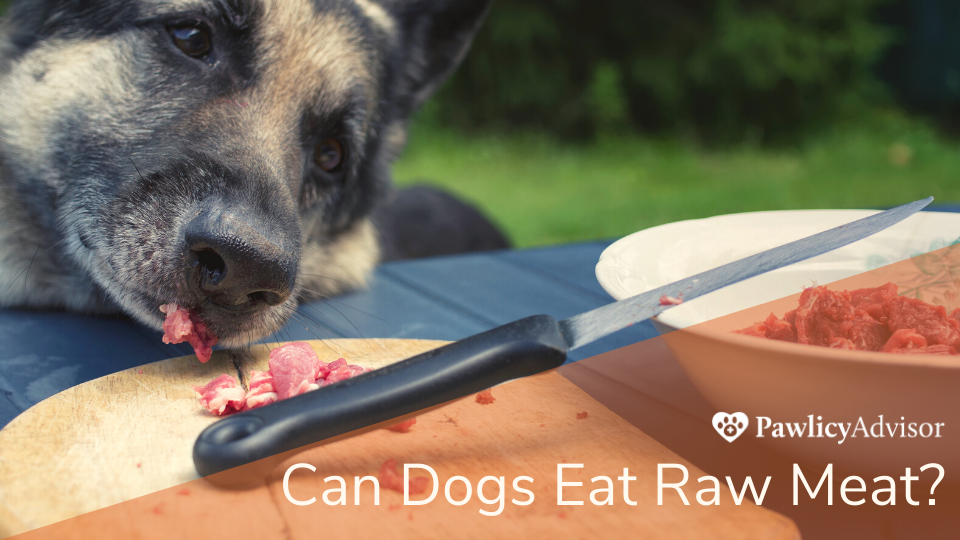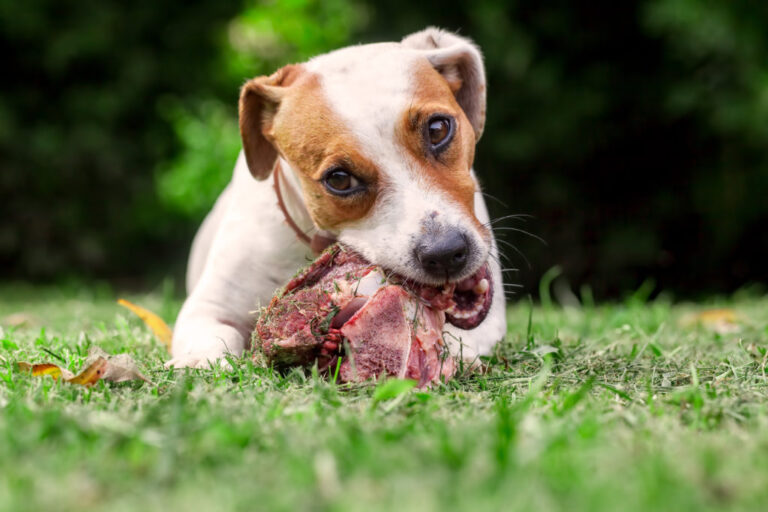If your dog eats raw meat, monitor for vomiting, diarrhea, or other signs of illness. Make sure to contact your veterinarian immediately for guidance and assessment.
Dogs eating raw meat may experience gastrointestinal upset or potentially serious health risks due to bacterial contamination. It’s essential to be proactive in seeking veterinary advice to ensure your dog’s well-being. Raw meat can carry harmful bacteria like Salmonella and E.
Coli, which can pose health hazards for your pet. Prompt action and professional guidance are crucial to address any potential issues arising from your dog’s consumption of raw meat. Taking quick and responsible steps will help safeguard your pet’s health and prevent any adverse effects. Be attentive and proactive in seeking help for your furry friend’s well-being.

Credit: www.pawlicy.com
Signs Of Raw Meat Ingestion
It can be a cause for concern if your dog ingests raw meat. While some pet parents choose to feed their furry friends a raw diet, there can be risks associated with this type of feeding regimen. If your dog accidentally consumes raw meat, it is essential to be aware of the signs that may indicate ingestion. Recognizing these signs can help you take appropriate action to ensure your dog’s well-being. Here, we will explore the various signs of raw meat ingestion that you should be aware of.
Behavioral Changes
When a dog consumes raw meat, there may be noticeable behavioral changes that can serve as indicators of ingestion. These behavioral changes can include:
- Restlessness or agitation, as the dog may feel uncomfortable or experience stomach upset.
- Excessive panting or drooling, which may signal discomfort or nausea.
- Increased thirst, as the dog’s body may try to compensate for any potential bacterial toxins ingested.
- Loss of appetite or refusal to eat, as the dog may instinctively avoid further ingestion of potentially harmful substances.
Observing these behavioral shifts can provide valuable insight into whether your dog has consumed raw meat.
Gastrointestinal Issues
One of the most common signs of raw meat ingestion in dogs is the development of gastrointestinal issues. These symptoms can include:
- Vomiting, which may occur shortly after consuming raw meat or later in the digestion process.
- Diarrhea, which can be accompanied by loose stools, increased frequency of bowel movements, or the presence of blood or mucus.
- Abdominal pain or discomfort, which may be evident through whining, restlessness, or a hunched posture.
- Flatulence or excessive gas, as the digestive system may struggle to process the raw meat properly.
It’s important to monitor your dog closely and consult your veterinarian if you notice any of these gastrointestinal symptoms.
Immediate Steps To Take
Dogs are natural scavengers and may consume raw meat if given the chance. While raw feeding is a popular trend among pet owners, it’s important to know what to do if your dog consumes raw meat unexpectedly. Taking immediate steps can help mitigate potential risks and ensure your dog’s well-being.
Monitor Your Dog
If your dog has consumed raw meat, monitor them closely for any signs of gastrointestinal distress or discomfort. Keep an eye out for symptoms such as vomiting, diarrhea, excessive drooling, or lethargy. Observe their behavior and appetite and note any unusual changes. By closely monitoring your dog, you can promptly identify any negative reactions to the raw meat consumption.
Contact Your Veterinarian
It’s crucial to contact your veterinarian as soon as possible after your dog has ingested raw meat. Inform them of the situation and provide details such as the type and amount of raw meat consumed, as well as any observed symptoms or changes in behavior. Your veterinarian will provide professional guidance and recommendations based on your dog’s specific situation. Seeking veterinary assistance promptly can help address any potential health issues and ensure the best course of action for your dog’s well-being.
Potential Risks And Complications
When your dog eats raw meat, there are several potential risks and complications that should be considered. These risks include foodborne illnesses and digestive system obstructions, which can have serious consequences for your pet’s health. It’s essential to be aware of these potential issues and take appropriate action to ensure your dog’s well-being.
Foodborne Illnesses
Foodborne illnesses are a significant concern when a dog consumes raw meat. Raw meat may contain harmful bacteria such as Salmonella, E. coli, or Listeria, which can lead to severe gastrointestinal issues in dogs. Symptoms of foodborne illnesses in dogs include vomiting, diarrhea, lethargy, and loss of appetite. It’s crucial to monitor your dog closely for any signs of illness and seek veterinary care if necessary.
Digestive System Obstructions
Another potential complication of a dog eating raw meat is the risk of digestive system obstructions. Consuming bones or large chunks of raw meat can lead to blockages in the digestive tract, causing pain and potential damage to the internal organs. It’s important to be cautious when feeding raw meat to your dog and ensure that it is appropriately prepared to minimize the risk of digestive obstructions.

Credit: www.diamondpet.com
Home Remedies And First Aid
When it comes to your dog ingesting raw meat, it’s important to act quickly and effectively. Home remedies and first aid can play a crucial role in addressing any potential issues. In this section, we will discuss two key steps you can take: inducing vomiting and feeding a bland diet.
Inducing Vomiting
If you suspect that your dog has consumed raw meat, inducing vomiting can help remove the potential toxins. However, it’s important to note that not all situations call for this method. Consult with your veterinarian before attempting to induce vomiting, especially if your dog shows any signs of discomfort or illness.
To safely induce vomiting, follow these steps:
- Keep calm to avoid alarming your dog. Approach them with a confident and reassuring demeanor.
- Mix a teaspoon of hydrogen peroxide (3% concentration) per 10 pounds of your dog’s weight.
- Using a syringe or dropper, administer the hydrogen peroxide slowly into your dog’s mouth.
- Walk your dog around or gently massage their abdomen to encourage the vomiting reflex.
- Allow your dog to vomit and ensure they are in a safe area away from any hazards.
If your dog does not vomit within 15 minutes, it’s recommended to consult your veterinarian immediately for further guidance.
Feeding A Bland Diet
After your dog has vomited or if inducing vomiting is not required, feeding a bland diet can help soothe their digestive system. This can be particularly beneficial if your dog experiences any gastrointestinal upset as a result of consuming raw meat.
| Ingredients | Instructions |
|---|---|
| Boiled white rice | Cook the rice until it is soft and easily digestible. Allow it to cool before serving. |
| Boiled chicken or turkey | Cook the chicken or turkey thoroughly, removing any bones or skin. Shred the meat into small, easy-to-eat portions. |
| Low-sodium chicken broth | Add a small amount of chicken broth to the rice and meat mixture to enhance palatability and moisture. |
Remember to feed this bland diet in small, frequent portions and monitor your dog’s response. If their symptoms persist or worsen, consult your veterinarian for further evaluation.
Preventive Measures For The Future
Now that you know what to do if your dog eats raw meat, it’s crucial to take preventive measures to avoid such incidents in the future. By following safe food handling practices and providing proper training and supervision, you can ensure your furry friend stays safe and healthy. Let’s delve into these preventive measures.
Safe Food Handling Practices
Implementing safe food handling practices is essential to prevent your dog from consuming raw meat. Here are some key steps to follow:
- Store raw meat properly: Keep raw meat in sealed containers in the fridge or freezer to prevent your dog from accessing it.
- Clean food preparation areas: Thoroughly clean any surfaces or utensils that come into contact with raw meat to avoid cross-contamination.
- Wash hands: Always wash your hands after handling raw meat to eliminate any potential bacteria transfer to your dog or yourself.
- Dispose of leftovers safely: If you have any leftover raw meat, dispose of it in a sealed bag and place it in a secure trash container.
Training And Supervision
In addition to safe food handling, training and supervision play a vital role in preventing your dog from consuming raw meat. Here are some steps to consider:
- Teach the “leave it” command: Train your dog to respond to the “leave it” command, which can help prevent them from snatching or eating any unwanted substances.
- Supervise mealtime: Monitor your dog during mealtime to prevent them from getting into any prohibited foods, including raw meat.
- Use food puzzles or toys: Engage your dog with food puzzles or toys to keep them mentally stimulated and less likely to attempt grabbing raw meat from the counter or trash.
- Encourage positive behavior: Reward your dog for good behavior and reinforce positive habits to discourage them from seeking out and consuming raw meat.
By practicing safe food handling and providing proper training and supervision, you can effectively minimize the risk of your dog eating raw meat in the future. Remember, prevention is always better than cure when it comes to your beloved pet’s well-being.

Credit: www.dogsnaturallymagazine.com
Frequently Asked Questions Of What To Do If Your Dog Eats Raw Meat
What Should I Do If My Dog Eats Raw Meat?
If your dog eats raw meat, it’s important to monitor them for any signs of illness such as vomiting or diarrhea. Contact your veterinarian for guidance, as raw meat can contain harmful bacteria. They may recommend monitoring your dog’s symptoms or bringing them in for an examination.
It’s always best to err on the side of caution when it comes to your pet’s health.
Is It Safe For Dogs To Eat Raw Meat?
While some people advocate for raw food diets for dogs, it’s important to consider the potential risks. Raw meat can contain harmful bacteria like Salmonella or E. coli, which can cause illness in both dogs and humans. Cooking meat thoroughly helps to eliminate these bacteria, so it’s generally safer to feed your dog cooked meat.
What Are The Possible Consequences Of Dogs Eating Raw Meat?
If dogs eat raw meat, they may experience digestive issues such as vomiting or diarrhea. Additionally, raw meat can contain bacteria that can lead to serious illness, including food poisoning. It’s important to monitor your dog for any signs of discomfort or illness and consult with your veterinarian if you have any concerns.
Conclusion
If your dog eats raw meat, it is important to take immediate action to ensure their health and safety. Consult with your veterinarian for advice on potential health risks and steps you can take to prevent future incidents. Implementing a balanced diet and proper training can help minimize the chances of your dog consuming unsafe food.
Remember to always supervise your dog’s meals and provide them with the necessary nutrients. Keeping your furry friend healthy is a top priority, so act swiftly and responsibly when faced with this situation.



